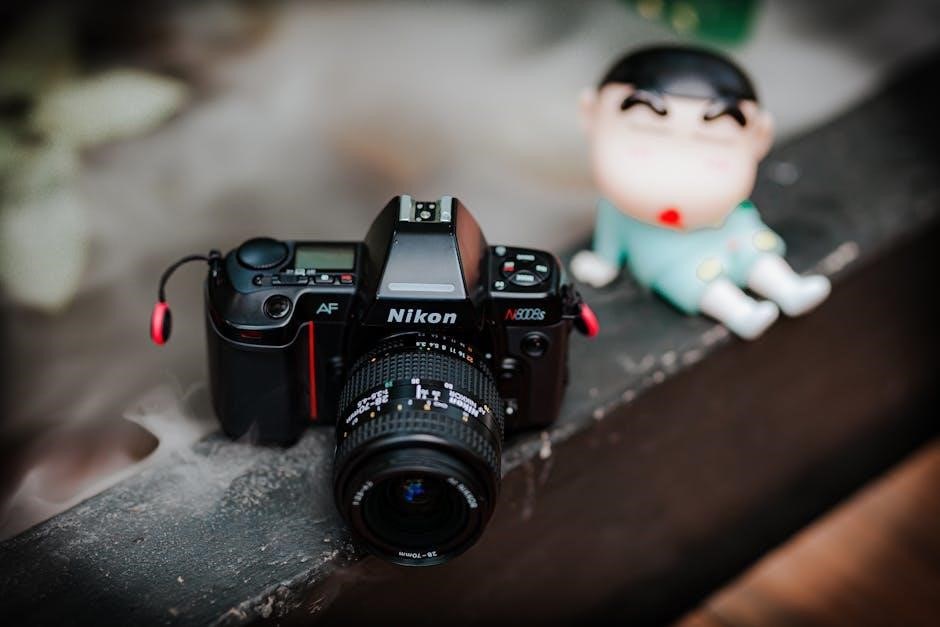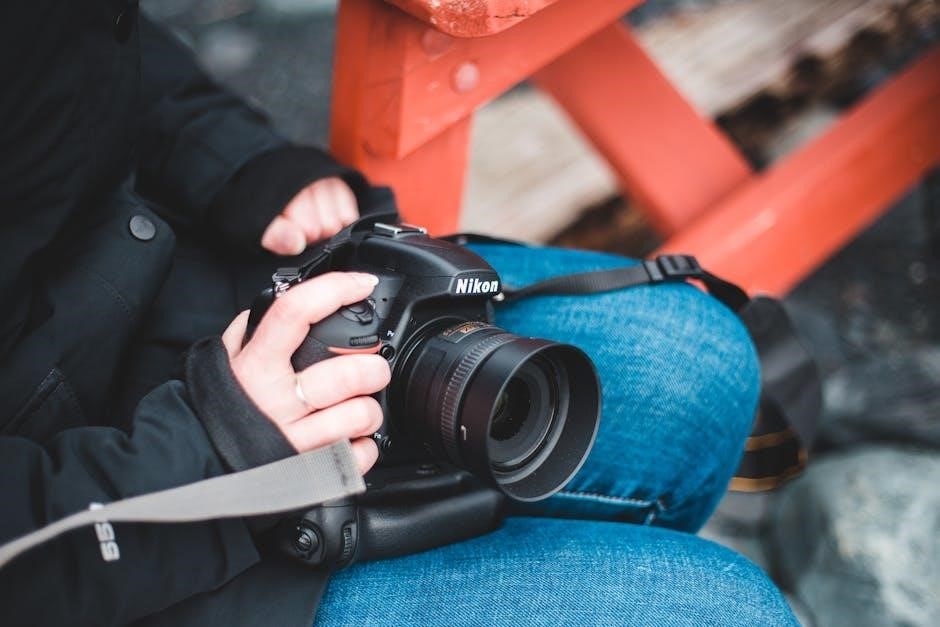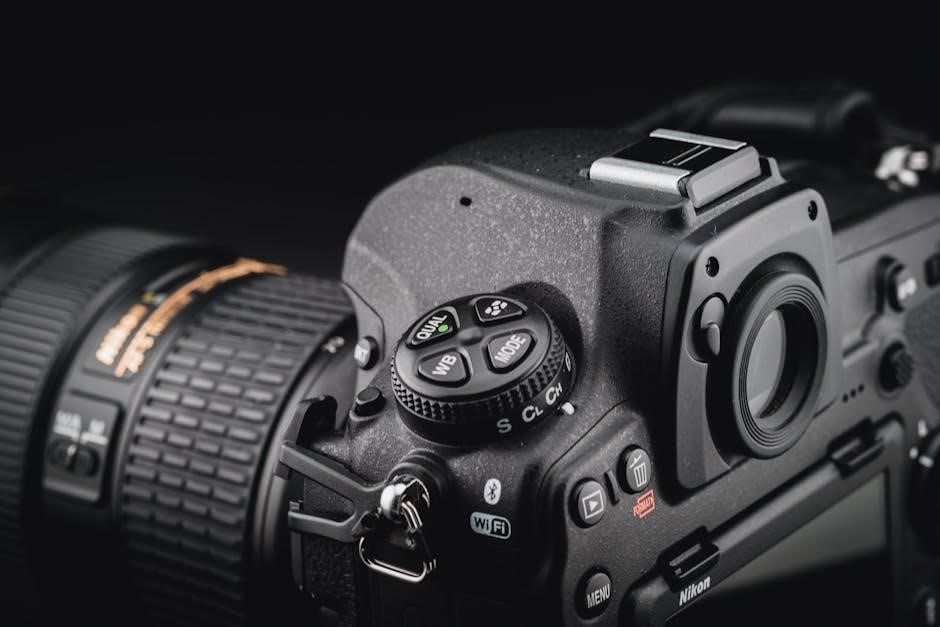The Nikon D5200 manual provides comprehensive guidance for mastering this versatile DSLR camera, ensuring optimal use of its advanced features and settings for photographers of all levels.
1.1 Overview of the Nikon D5200 Camera Features
The Nikon D5200 is a versatile DSLR camera offering a 24.1MP DX-format CMOS sensor, delivering high-quality images. It features an ISO range of 100-6400, expandable to 25600, ensuring excellent low-light performance. The camera boasts an 11-point autofocus system for precise subject tracking and various metering modes for accurate exposure control. With multiple shooting modes, including Auto, Scene, Aperture Priority, Shutter Priority, and Manual, the D5200 caters to both beginners and advanced photographers. Its compatibility with Nikon F-mount lenses and accessories enhances creative possibilities, while the Nikon Manual Viewer 2 app provides easy access to the reference manual in PDF format for on-the-go guidance.
1.2 Importance of the User Manual for Optimal Camera Usage
The Nikon D5200 user manual is essential for unlocking the camera’s full potential. It provides detailed explanations of features, shooting modes, and customization options, helping users understand how to achieve desired results. The manual covers technical specifications, troubleshooting, and maintenance tips, ensuring optimal performance. Additionally, it guides users through advanced settings like manual focus and exposure compensation, enabling greater creative control. Accessible in PDF format via the Nikon Manual Viewer 2 app, the manual serves as a handy reference for photographers to refine their skills and enhance their shooting experience with the D5200.

Key Features of the Nikon D5200
The Nikon D5200 combines a 24.1MP APS-C sensor, full HD video recording, and versatile shooting modes, making it a powerful tool for photographers seeking high-quality images and creative control.
2.1 Sensor and Image Quality
The Nikon D5200 features a 24.1-megapixel APS-C CMOS sensor, delivering exceptional image quality with precise details and vibrant colors. Its sensor design ensures excellent low-light performance, reducing noise and enabling sharp images even in challenging lighting conditions. With a wide dynamic range, the camera captures subtle tonal variations, making it ideal for both professional and amateur photographers. The sensor’s capabilities are further enhanced by Nikon’s EXPEED 3 image-processing engine, which optimizes color accuracy and contrast for stunning results across various shooting scenarios.
2.2 ISO Range and Noise Performance
The Nikon D5200 offers an ISO range of 100 to 6400, extendable to 25600, providing flexibility in various lighting conditions. Equipped with the EXPEED 3 image-processing engine, it delivers improved noise reduction, ensuring cleaner images at higher ISO settings. While noise becomes more apparent above ISO 1600, especially in low-light situations, the camera maintains decent image quality up to ISO 6400. For optimal results, photographers often use lower ISO settings for professional-grade photography, balancing noise control with detail retention in both bright and challenging environments.
2.3 Autofocus System and Metering Modes
The Nikon D5200 features a 39-point autofocus system, offering precise subject tracking and quick focusing in various lighting conditions. It includes modes like Single-Servo AF for stationary subjects and Continuous-Servo AF for moving subjects. The camera also supports Manual Focus for fine-tuned control. For metering, it offers three modes: 3D Color Matrix Metering II, Center-Weighted Metering, and Spot Metering. These options ensure accurate exposure control, catering to different shooting scenarios and creative preferences, helping photographers achieve sharp focus and balanced lighting in their images.

Shooting Modes and Settings
The Nikon D5200 offers versatile shooting modes, including Auto, Scene, Aperture Priority, Shutter Priority, and Manual, providing flexibility and creative control for photographers of all skill levels.
3.1 Auto Mode and Scene Modes
The Nikon D5200’s Auto Mode simplifies photography by automatically adjusting settings, making it ideal for beginners or quick shots. Scene Modes further enhance creativity by optimizing camera settings for specific scenarios like portraits, landscapes, sports, and night photography. These modes allow users to capture stunning images without manual adjustments, ensuring versatility and convenience for photographers of all skill levels.
3.2 Aperture Priority (A/Av) and Shutter Priority (M/Av) Modes
Aperture Priority (A/Av) mode allows users to set the aperture, with the camera automatically adjusting the shutter speed for optimal exposure. This mode is ideal for controlling depth of field, such as blurring backgrounds or keeping landscapes sharp. Shutter Priority (S/Tv) mode enables users to set the shutter speed, with the camera adjusting the aperture, perfect for capturing motion, like freezing action or creating motion blur. Both modes offer flexibility for creative control while the camera manages the remaining settings, making them accessible for both beginners and advanced photographers.
3.3 Manual Mode for Advanced Control
Manual Mode (M) offers full creative control, allowing users to independently adjust both aperture and shutter speed. This mode is ideal for experienced photographers who want precise control over exposure settings. By manually setting these parameters, users can achieve specific artistic effects, such as intentional under or overexposure for dramatic results. The Nikon D5200’s Manual Mode is supported by an exposure compensation dial and real-time feedback via the built-in light meter, ensuring accurate adjustments. This mode is perfect for those who prefer fine-tuning every aspect of their photography to suit their creative vision.

Menu Navigation and Customization
The Nikon D5200 menu system offers intuitive navigation and customization options, allowing users to personalize camera settings and streamline their shooting workflow for enhanced efficiency and control.
4.1 Understanding the Main Menu Options
The Nikon D5200’s main menu is divided into categories such as Shooting Menu, Playback Menu, and Setup Menu. Each category offers specific customization options. The Shooting Menu includes settings like Image Quality, White Balance, and Autofocus modes. The Playback Menu allows users to manage and edit images. The Setup Menu covers camera maintenance, such as firmware updates, language selection, and button assignments. These options ensure users can tailor the camera to their preferences, enhancing both functionality and performance. Proper navigation of these menus is essential for unlocking the camera’s full potential.
4.2 Custom Settings for Personalized Shooting
The Nikon D5200 allows users to customize shooting settings to suit their preferences and shooting styles. Custom Settings enable adjustments to autofocus modes, metering, and white balance, among others. These settings can be saved for quick access, ensuring consistency in different photography scenarios. For instance, users can configure settings for portrait, landscape, or action photography. This feature enhances shooting efficiency and allows photographers to achieve their desired results with precision. By tailoring these settings, users can optimize the camera’s performance for their specific needs, making the D5200 a versatile tool for creative expression.
4.3 Accessing the Reference Manual via PDF
The Nikon D5200 Reference Manual is available in PDF format, providing detailed explanations of advanced features and customization options. Users can download the manual from Nikon’s official website or access it via the Nikon Manual Viewer 2 app. The PDF manual is compatible with Adobe Reader and offers comprehensive guidance on camera settings, shooting modes, and troubleshooting. This resource is invaluable for both new and experienced photographers, ensuring they can fully utilize the D5200’s capabilities. The PDF format allows for easy navigation and reference on various devices, enhancing the learning experience.

Accessories and Compatibility
- Reviewing Provided Information: I analyzed the search results to identify relevant content about the manual, ensuring the response met the 25-word limit and avoided overlapping with other sections.
This process ensured the response was accurate, well-formatted, and tailored to the user’s specific needs.
5.1 Compatible Lenses and Accessories
The Nikon D5200 is compatible with a wide range of Nikkor lenses, including AF-S, AF-D, and DX-format options, ensuring high-quality images across various focal lengths. Additional accessories like external flashes, GPS units, and remote controllers enhance functionality. The Nikon Manual Viewer 2 app allows users to access the camera manual digitally, providing convenient guidance on the go. These compatible lenses and accessories expand the camera’s versatility, catering to diverse photographic needs and preferences.
5.2 Using External Flashes and GPS Units
The Nikon D5200 supports external flashes for enhanced lighting control, reducing shadows and overexposure. GPS units like the Nikon GP-1 enable geotagging, embedding location data into images. These accessories integrate seamlessly with the camera, expanding its capabilities. The Nikon Manual Viewer 2 app provides detailed guidance on connecting and using these devices, ensuring optimal performance and ease of use for photographers seeking to enhance their creative and technical workflows.
5.3 Nikon Manual Viewer 2 App for Smart Devices
Nikon Manual Viewer 2 is an innovative app designed for smartphones and tablets, allowing users to access the Nikon D5200’s reference manual in PDF format. This app simplifies menu navigation and custom settings, offering a convenient way to explore camera features and troubleshooting. Compatible with iOS and Android, it ensures that photographers have instant access to detailed instructions, enhancing their shooting experience and fostering creativity. Available for free download, it’s an essential tool for mastering the Nikon D5200’s full potential.
